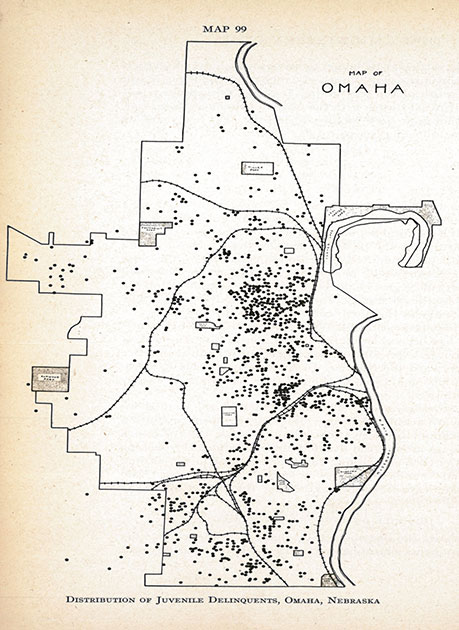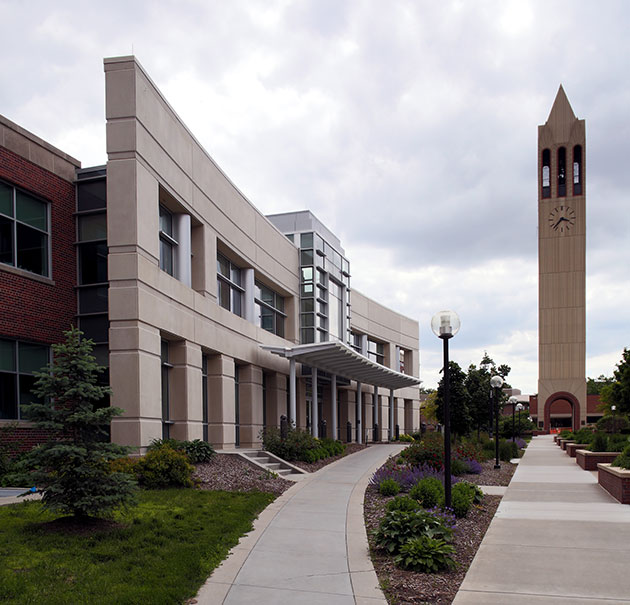A Brief History of the School of Criminology and Criminal Justice
Organizing a Department
The earliest evidence of criminology at the University of Nebraska at Omaha is traced to T. Earl Sullenger who taught between 1923 and 1958. Professor Sullenger founded the sociology department at "University of Omaha' and as was common at the time, offered courses on criminology and related topics. He also published a number of books and articles on issues related to crime and deviance. Some of Sullenger's work was published in American Journal of Sociology, Journal of Criminal Law and Criminology, and Social Forces. Sullenger also contributed a chapter on crime in Omaha to Clifford Shaw and Henry McKay’s famous classic study Juvenile Delinquency in Urban Areas (see image below). The sociology department continued to offer criminology courses into the 1960s.

In 1962, the College of Adult Education began offering a Bachelor of Science degree in Law Enforcement and Security. In 1966, under the direction of Professor Gaylon Kuchel, the Department of Law Enforcement and Correction was formed.
In the summer of 1966, eight students (including one woman) became the first graduates of the program. The program quickly grew and expanded to include an associate degree, which produced its first graduates in summer of 1967. In 1971, the Nebraska State Commission on Law Enforcement and Criminal Justice provided the department funding to develop a degree program on the Lincoln campus of the University of Nebraska system. In fall of 1972, several full-time faculty were assigned to the Lincoln campus and students were offered the opportunity to complete their bachelor of science degree in law enforcement and corrections from the University of Nebraska at Omaha entirely on the Lincoln campus.
Building a Graduate Program
In 1972, the Department of Law Enforcement and Correction became the Department of Criminal Justice and moved to the School of Public Affairs, which became the College of Public Affairs in 1973. In 1973, the Law Enforcement Assistance Administration provided a grant that required the department to join an informal 5 university consortium that would investigate and develop graduate-level education in criminal justice. In 1974, to assist with this goal the Department of Criminal Justice hired 3 new faculty members: William “Bill” Wakefield, Samuel Walker, and Vincent Webb who would eventually become both prolific scholars and leaders in the discipline. Dr. Webb was appointed chair of the department in 1975, a position he held for the next 20 years. In 1976, a Master of Science degree and a Master of Arts degree in Criminal Justice were approved by the Board of Regents. Dr. Webb provides a first-hand account of the history of criminology in this video.
Over the next three decades the department grew enrollment and faculty on both the Omaha and Lincoln campuses. The department became recognized as a national leader in criminological education and research. In 1993, the Nebraska Board of Regents granted permission to begin a Doctoral degree in Criminal Justice, the first free standing Ph.D. program to be offered by the University of Nebraska at Omaha, and the 13th such program nationally. The first cohort of Ph.D. students was admitted in 1994, and Charles Katz and Ni “Phil” He were the first graduates of the program in 1997. Dr. Ni "Phil" He would eventually return to UNO in 2023 to serve as the campus Senior Vice Chancellor.
Expanding to a School
In 2006, the Department of Criminal Justice broadened its mission and scope and became the School of Criminology and Criminal Justice, boasting a top ten national rank according to U.S. News and World Report. The School was home to a large, well-respected, and research productive faculty on both the Omaha and Lincoln campuses. In 2002, the School established the Juvenile Justice Institute to efficiently meet research needs of the Nebraska juvenile justice system. In 2009, the School established the Consortium for Crime and Justice Research, which has since become the Nebraska Center for Justice Research, in response to a need for more comprehensive research on regional and national crime and justice issues.
Now, under the direction of Dr. Todd Armstrong, the SCCJ remains a nationally recognized leader in criminological research and education. Faculty within the school are actively involved in research activities that impact the field of criminology and criminal justice. Over the years, the faculty members have included several fellows and past presidents of the American Society of Criminology, the Academy of Criminal Justice Sciences, and the Association of Doctoral Programs in Criminology and Criminal Justice. The school serves approximately 900 undergraduate students between the Omaha and Lincoln campuses of the University of Nebraska, and approximately 150 masters’ students and 25 doctoral students.
